What exactly is a
world’s fair? Is it a fair, an exhibition, a gathering place? It’s
all those things and more. People have been going to fairs of one
kind or another for centuries.
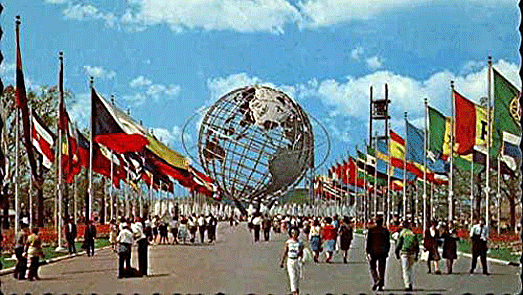
Where and when the first fair was held isn’t known, however,
evidence points to the existence of fairs as early as 500 BCE in the
eastern Mediterranean. Back then they had more to do with trade and
commerce—a sort of marketplace, such as the great camel fairs in
Arabia. Fairs were also tied to festivals and religious feasts. As
the fair evolved in Western Europe, it became a place for trading
agricultural products. But it wasn’t until Prince Albert of England
linked a fair to science and technology in 1851 that the first
world’s fair was born.
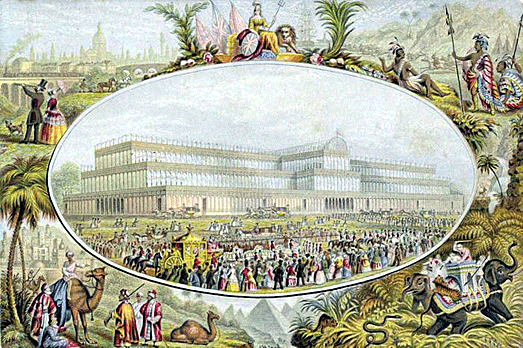
For over 150 years, the public has been inspired by and in awe of
the world’s fair. Since making its grand debut in Victorian London,
the international spectacle has celebrated the achievements of
countries across the globe, including industrial inventions,
scientific advancements, and cultural contributions.
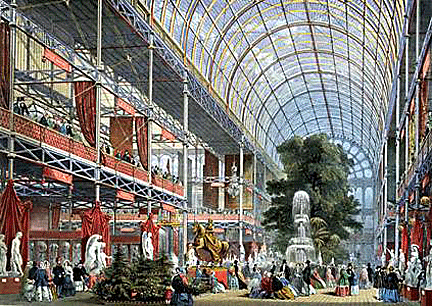 Inspired
by a string of national exhibitions in 18th and 19th-century
Britain, London hosted the first world’s fair, The Great Exhibition
of the Works of Industry of All Nations, in 1851. With a focus on
both enlightening and entertaining, this exposition showcased the
industry of nations around the world, introducing audiences to
“exotic” ideas and paving the way for future world’s fairs.
Inspired
by a string of national exhibitions in 18th and 19th-century
Britain, London hosted the first world’s fair, The Great Exhibition
of the Works of Industry of All Nations, in 1851. With a focus on
both enlightening and entertaining, this exposition showcased the
industry of nations around the world, introducing audiences to
“exotic” ideas and paving the way for future world’s fairs.
As the world’s fairs
evolved, they featured a wide variety of exhibitions of industrial,
scientific, and cultural items on display at a specific site for a
period of time, ranging usually from three to six months. World’s
fairs include exhibits from a significant number of countries and
often have an entertainment zone in which visitors can enjoy rides,
exotic attractions, and food and beverages. Since the mid-19th
century more than 100 world’s fairs have been held in more than 20
countries throughout the world.
The Bureau
International des Expositions (BIE), a Paris-based organization
established in 1928, governs and regulates these fairs. Its
objective is to bring order to exposition scheduling and to make
clear the rights and responsibilities of the host city and
participants. The original convention that established the BIE and
set up guidelines for expositions has been revised a number of
times, but as of the early 21st century a large exposition, termed a
“registered exhibition,” could be held once every five years, and
one smaller exposition, called a “recognized exhibition,” could be
held during the interval.
Early National Exhibitions
The English national fairs of the 18th century, which combined trade
shows with carnival-like public entertainment, were among the
forerunners of the modern world’s fair.
The British mechanics’ institutes began sponsoring exhibitions in
the 1830s. They brought scientific education to craftsmen and
factory workers, and their exhibitions displayed tools and other
labor-saving mechanical devices based on the latest scientific
inventions. These exhibitions also featured entertainment and exotic
displays, such as so-called “genuine historical relics” of sometimes
dubious authenticity, as well as fine arts shows that mingled works
by local and national artists.
Prince Albert’s Great Exhibition And
Its Legacy
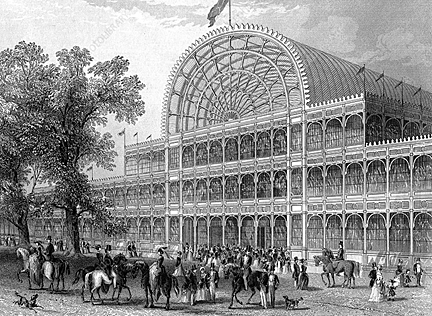 The
idea of a grand exhibition wasn’t entirely new but drew on
exhibitions that had gone before it. British inventor Sir Henry Cole
and Prince Albert planned what came to be commonly known as the
Crystal Palace Exhibition, held in London’s Hyde Park between May 1
and October 15, 1851. This show placed an emphasis on new
technologies—including an early model of the fax machine and an
advanced telescope—as well as extraordinary curiosities, like a rare
Celtic brooch and the world’s largest diamond.
The
idea of a grand exhibition wasn’t entirely new but drew on
exhibitions that had gone before it. British inventor Sir Henry Cole
and Prince Albert planned what came to be commonly known as the
Crystal Palace Exhibition, held in London’s Hyde Park between May 1
and October 15, 1851. This show placed an emphasis on new
technologies—including an early model of the fax machine and an
advanced telescope—as well as extraordinary curiosities, like a rare
Celtic brooch and the world’s largest diamond.
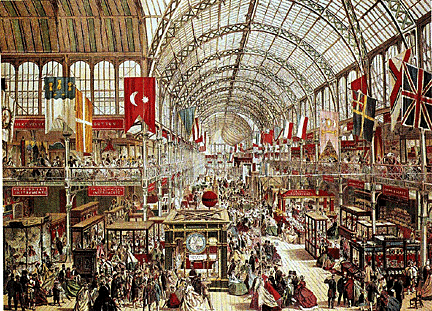 A
royal commission chaired by Prince Albert held a competition for a
building design. Ultimately, however, the commission rejected all
the entries submitted and instead chose a design by Joseph Paxton, a
greenhouse builder. Paxton’s iron-and-glass structure, dubbed the
Crystal Palace, delighted the public and contributed to the success
of the exhibition.
A
royal commission chaired by Prince Albert held a competition for a
building design. Ultimately, however, the commission rejected all
the entries submitted and instead chose a design by Joseph Paxton, a
greenhouse builder. Paxton’s iron-and-glass structure, dubbed the
Crystal Palace, delighted the public and contributed to the success
of the exhibition.
The exhibits on display inside the Crystal Palace included
scientific and technological marvels from many different countries
as well as works of art and craftsmanship. Some six million people
attended the exhibition, which earned a substantial profit, one of
only two fairs to do so.
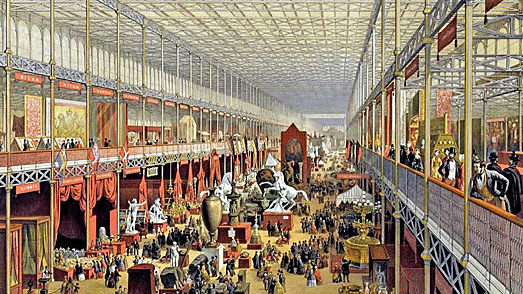
The critical and financial success of the exhibition ensured that
world’s fairs would continue to be held. The period between 1880 and
World War I was a golden age of these fairs, with more than 40
international expositions held in locations as varied as
Australia---Melbourne, Victoria in 1888 and Hobart, Tasmania in 1894
and 1895—Guatemala City, Guatemala in 1897, and in Hanoi in1901 and
1903, then located in French Indochina and now the capital of
Vietnam..
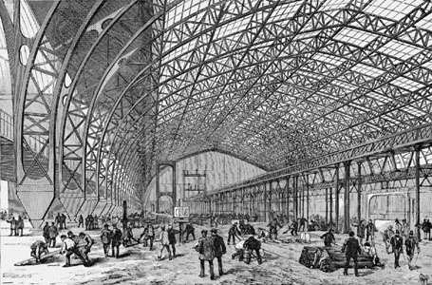 Not
to be outdone by the British, Americans mounted the Exhibition of
the Industry of All Nations, more commonly known as the New York
Crystal Palace Exhibition, held in 1853 and 1854 in an
iron-and-glass structure in Bryant Park. It showcased the same types
of displays as its London counterpart but also included an
especially impressive sculpture collection. Unfortunately,
attendance never measured up to expectations, and it ended with a
substantial financial loss. It would be more than 20 years before
another exposition occurred in the United States.
Not
to be outdone by the British, Americans mounted the Exhibition of
the Industry of All Nations, more commonly known as the New York
Crystal Palace Exhibition, held in 1853 and 1854 in an
iron-and-glass structure in Bryant Park. It showcased the same types
of displays as its London counterpart but also included an
especially impressive sculpture collection. Unfortunately,
attendance never measured up to expectations, and it ended with a
substantial financial loss. It would be more than 20 years before
another exposition occurred in the United States.
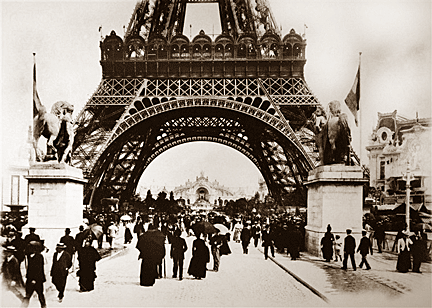 As
rivals to the British, the French mounted their own exhibitions.
Fair organizers in Paris held the first in a long series of
international expositions in 1855. The exposition occupied a larger
space and included exhibits from more countries than the Crystal
Palace, and it presented several new features, such as reduced
admission prices on Sundays and a separate fine arts pavilion that
contained some 5,000 works by artists from 29 countries. Although it
lost money, the 1855 Paris exposition left such a positive legacy
that the government sponsored subsequent expositions in 1867, 1878,
1889, and 1900, each attracting a larger attendance than the
previous one.
As
rivals to the British, the French mounted their own exhibitions.
Fair organizers in Paris held the first in a long series of
international expositions in 1855. The exposition occupied a larger
space and included exhibits from more countries than the Crystal
Palace, and it presented several new features, such as reduced
admission prices on Sundays and a separate fine arts pavilion that
contained some 5,000 works by artists from 29 countries. Although it
lost money, the 1855 Paris exposition left such a positive legacy
that the government sponsored subsequent expositions in 1867, 1878,
1889, and 1900, each attracting a larger attendance than the
previous one.
By the 1870s the international exposition movement had become well
established, and the planners of the centennial commemoration of
America’s Declaration of Independence concluded that a world’s fair
would be the most appropriate type of celebration. Consequently, the
U.S. Centennial Exhibition, held in Philadelphia in 1876, was a
critical success and attendance of just under 10 million was enough
to offset a large financial loss. It inspired a rush of world’s
fairs in the United States, especially in the South, over the next
40 years.
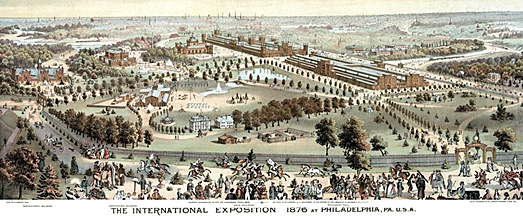
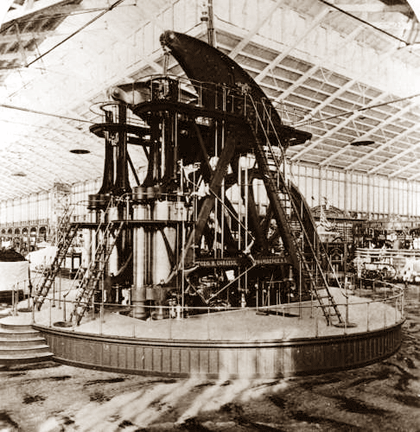 The
Philadelphia centennial exhibition showcased the products of the
early Industrial Revolution in America. The 700-ton Corliss engine,
the largest steam engine ever built amazed fairgoers, as well as new
inventions such as the telephone, the typewriter, and the mechanical
calculator. In addition, the exposition hosted the first
international art exhibition in the United States and was the first
to spread exhibits out over several large, topically designated
pavilions, a practice that soon became standard. Some 24 states
erected their own pavilions as well, an idea repeated at many later
fairs.
The
Philadelphia centennial exhibition showcased the products of the
early Industrial Revolution in America. The 700-ton Corliss engine,
the largest steam engine ever built amazed fairgoers, as well as new
inventions such as the telephone, the typewriter, and the mechanical
calculator. In addition, the exposition hosted the first
international art exhibition in the United States and was the first
to spread exhibits out over several large, topically designated
pavilions, a practice that soon became standard. Some 24 states
erected their own pavilions as well, an idea repeated at many later
fairs.
When they weren’t marveling at the first transcontinental telephone
call or admiring the on-loan Liberty Bell, visitors spent their time
strolling down wide boulevards, attending scientific and educational
presentations, “traveling” to international pavilions and enjoying
thrilling displays of sports, racing, music and art.
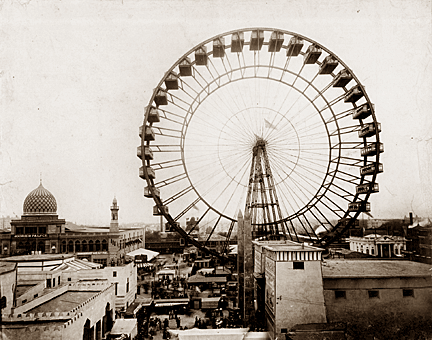 Although
there were many important expositions in the last decades of the
19th century, the World’s Columbian Exposition in Chicago in 1893
was the most significant world’s fair in U.S. history and one of the
most important in the history of world expositions. Coming soon
after the spectacular 1889 exposition in Paris, where the Eiffel
Tower was the main attraction, the World’s Columbian Exposition, in
the minds of its organizers, had to be bigger and more important
than its Parisian predecessor. Chicago’s managers never found a
signature structure to surpass the Eiffel Tower but they did create
an exposition whose architecture shaped the country’s style for the
next 25 years and whose exhibits were more impressive than anything
seen before. Moreover, the exposition introduced the concept of the
midway, a lively entertainment zone, a feature that soon became a
staple of virtually all future expositions.
Although
there were many important expositions in the last decades of the
19th century, the World’s Columbian Exposition in Chicago in 1893
was the most significant world’s fair in U.S. history and one of the
most important in the history of world expositions. Coming soon
after the spectacular 1889 exposition in Paris, where the Eiffel
Tower was the main attraction, the World’s Columbian Exposition, in
the minds of its organizers, had to be bigger and more important
than its Parisian predecessor. Chicago’s managers never found a
signature structure to surpass the Eiffel Tower but they did create
an exposition whose architecture shaped the country’s style for the
next 25 years and whose exhibits were more impressive than anything
seen before. Moreover, the exposition introduced the concept of the
midway, a lively entertainment zone, a feature that soon became a
staple of virtually all future expositions.
It also boasted an array of rides, including the world’s first
Ferris Wheel and a moveable walkway. Additionally, the World’s
Columbian Exposition was the first to feature international
pavilions, an important element of fairs to follow.
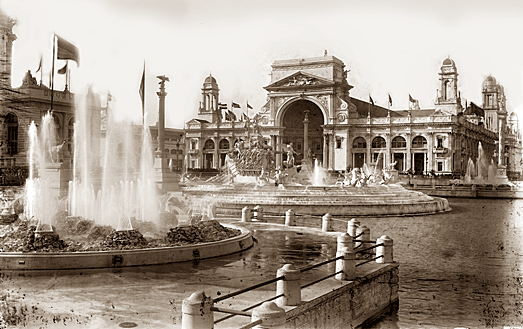
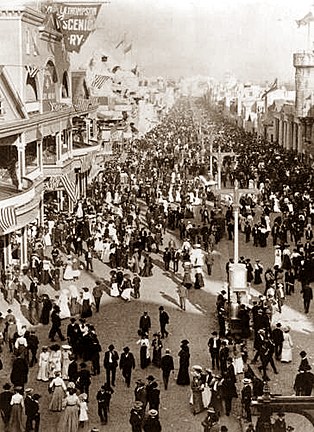 The
World’s Columbian Exposition marked the peak of the golden age of
fairs. It was more spectacular than anything that had preceded it,
and, with the possible exception of the great Exposition Universelle
in Paris in 1900, no later exposition matched its splendor or its
influence. Still, a major international exposition occurred almost
annually somewhere in the world between 1893 and 1916, when World
War I brought a temporary end to the movement. Some, like St. Louis
in 1904 and San Francisco in 1915, were large and showy. Others,
like the Jamestown Exhibition—held in Norfolk, Virginia in 1907 for
the 300th anniversary of the Jamestown Colony—were smaller and
marked important historical anniversaries. Still others, like
London’s Franco-British Exhibition in 1908, signified bilateral
friendship. In addition, some smaller countries hosted expositions
to mark their emergence onto the international scene, such as the
Belgian expositions in Liège in 1905 and Brussels in 1910.
The
World’s Columbian Exposition marked the peak of the golden age of
fairs. It was more spectacular than anything that had preceded it,
and, with the possible exception of the great Exposition Universelle
in Paris in 1900, no later exposition matched its splendor or its
influence. Still, a major international exposition occurred almost
annually somewhere in the world between 1893 and 1916, when World
War I brought a temporary end to the movement. Some, like St. Louis
in 1904 and San Francisco in 1915, were large and showy. Others,
like the Jamestown Exhibition—held in Norfolk, Virginia in 1907 for
the 300th anniversary of the Jamestown Colony—were smaller and
marked important historical anniversaries. Still others, like
London’s Franco-British Exhibition in 1908, signified bilateral
friendship. In addition, some smaller countries hosted expositions
to mark their emergence onto the international scene, such as the
Belgian expositions in Liège in 1905 and Brussels in 1910.
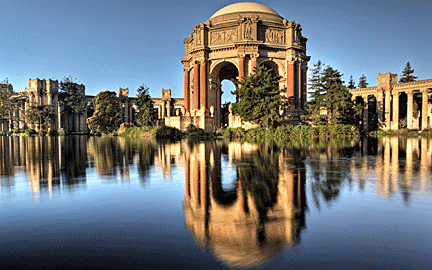 The
world’s fairs held in the United States were somewhat different from
those held in Europe. U.S. participation in European fairs was
privately managed. Besides being mostly privately run, American
world’s fairs included rides, exotic attractions, and by the 1890s,
foreign or native “villages” that showed fairgoers the way of life
of groups from Africa, Asia, and the South Pacific islands, who were
generally presented as belonging to “primitive” societies. By the
first decade of the 20th century, fairs in Europe also had adopted
these types of entertainment attractions.
The
world’s fairs held in the United States were somewhat different from
those held in Europe. U.S. participation in European fairs was
privately managed. Besides being mostly privately run, American
world’s fairs included rides, exotic attractions, and by the 1890s,
foreign or native “villages” that showed fairgoers the way of life
of groups from Africa, Asia, and the South Pacific islands, who were
generally presented as belonging to “primitive” societies. By the
first decade of the 20th century, fairs in Europe also had adopted
these types of entertainment attractions.
The Turning Point for World’s Fairs
World War I was the turning point for world’s fairs. After the War,
fairs never regained the cultural status they had enjoyed before the
war. Fewer were held, and many weren’t artistically or commercially
successful. With improved transportation and communication, fairs
had less to offer people who could now see movies or hear radio
programs about foreign lands or even travel relatively easily to
visit them firsthand.
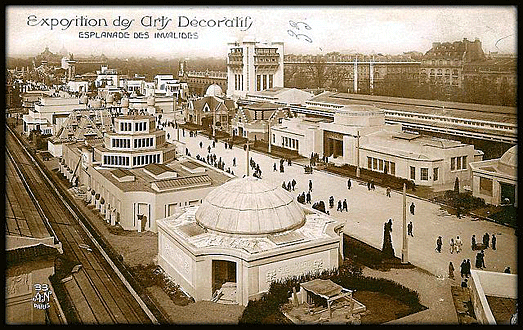
Nonetheless, there were some noteworthy expositions during this
time. The Exposition Internationale des Arts Décoratifs et
Industriels Modernes, held in Paris in 1925, made the architectural
and design style known as Art Deco highly popular for the next 15
years. The
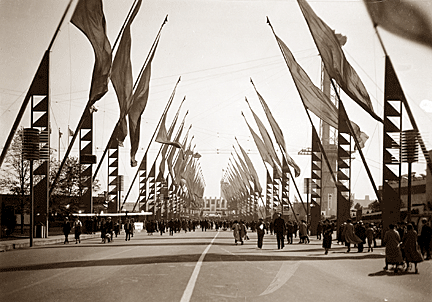 British Empire Exhibition in Wembley in 1924 and 1925,
the Exposition Coloniale Internationale in Paris in 1931, and the
Exposition Universelle et Internationale in Brussels in 1935
showcased the overseas empires of these three countries at a time
when rumblings of independence were just beginning to be heard from
their colonies.
British Empire Exhibition in Wembley in 1924 and 1925,
the Exposition Coloniale Internationale in Paris in 1931, and the
Exposition Universelle et Internationale in Brussels in 1935
showcased the overseas empires of these three countries at a time
when rumblings of independence were just beginning to be heard from
their colonies.
Two
American expositions of the 1930s deserve special mention. The
Century of Progress Exposition in Chicago in 1933 and 1934 and the
New York World’s Fair in 1939 and 1940 were both exciting examples
of Art Deco architecture, designed to take fairgoers’ minds off the
Great Depression by suggesting the wonderful future that awaited
them once the hard times were over.
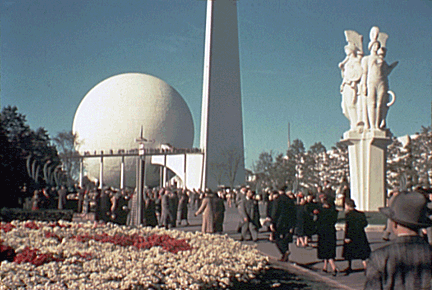 The
1939–40 New York World's Fair, and those that followed, took a
different approach, one less focused on technology and aimed more at
cultural themes and social progress. For instance, the theme of the
1939 fair was "Building the World of Tomorrow"; at the 1964–65 New
York World's Fair, it was "Peace Through Understanding."
Unfortunately, the BIE had refused to sanction the fair because of
the organizers’ refusal to follow its guidelines.
The
1939–40 New York World's Fair, and those that followed, took a
different approach, one less focused on technology and aimed more at
cultural themes and social progress. For instance, the theme of the
1939 fair was "Building the World of Tomorrow"; at the 1964–65 New
York World's Fair, it was "Peace Through Understanding."
Unfortunately, the BIE had refused to sanction the fair because of
the organizers’ refusal to follow its guidelines.
Today, people can see and hear what’s happening all over the world
at the touch of a button or the swipe of a smartphone screen. New
technology happens faster than people can absorb it. In this digital
age, world’s fairs such as existed in the 19th and early 20th
century now seem redundant.
